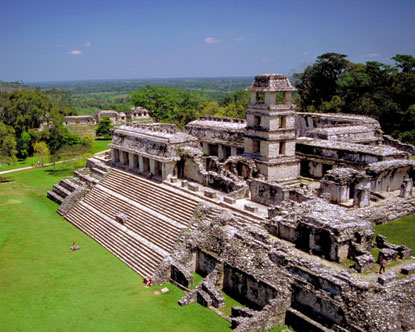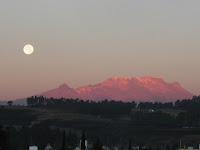
Here are some photos from the Ruta Maya, which we will be traveling this April and May, I hope that you folk are as excited as I am. The Ruta Maya is a travel route prepared by the Mexican Secretary of Communications and Transport as part of the bicentennial celebrations in 2010.
2010, being the 200th anniversary of the Mexican Independence and the 100th of the Mexican Revolution, the government has put a ton of new tourist activities around the country For example, some really cool signs saying "Quieres saber qué pasó aquí?" (Do you want to know what happened here?) that provide a number that, if one sends a text message to it, will reply with information about the site. A really interesting idea, seen here in a photo from
El señor del hospital.

Another example are road signs that point out interesting sites that are either historically or culturally significant. They are pretty interesting too, though one would need to be pretty bored to drve around follwing them. Well, I would if I had a car and a buddy, but I'm strange.
Anyway, what I was saying before. There are various Rutas, like the Ruta de la Independencia that we went through in November and December, la Ruta del Tequila, la Ruta de la Revolución, etc. Basically, the idea is to follow the path of a certain event in Mexican History, a passively guided your established by the government. I think it's an awesome idea. So, here are some pictures of places that we will visit on the way.

Here is where we'll be the second day of the trip, after the first really heavy day of travel to get to the southern part of México, specifically
Tuxtla Gutiérrez, the capital of the state of Chiapas. This state is known for it's jungles and isolation, I'm really excited to check it out. This photo is from el
Cañón del Sumidero, or the Sink Canyon, where we will be the second day ----------
>>>>>
The third day, we'll wander around Tapachula, another city in Chiapas, and later go to a water park type deal.
Later, we will head down to Guatemala to the District Conference, with all the exchange students from all over México, it should be awesome. We'll also get to explore in Antigua Guatemala, and stay there for three dys until we head back to Tapachula.
From Tapachula, we'll wander around the
Yucatán Peninsula for awhile, visiting
Agua Azul, a beautiful natural park. From there, it's the route to
Palenque, which I'm sure will be my favorite part.
Palenque was a huge Maya city in the jungle of Chiapas that flourished in from 100 BC to about 800 AD, one of the most important ceremonial, trade, and government centers of the Mayan Empire. I love the Mayas, and I'll tell you why. One of the most important things in life is knowing the area that you're in, and these guys took it to extremes. They not only predicted floods, harvested and planted according to the seasons, created two
calendars that are more accurate than the Gregorian one that we use, used an advanced
writing system, and made considerable contributions to architecture, city planning, mathematics, and many other fields, they also studied and created the most developed body of astronomical knowledge of their time. The Mayas were one of the longest-lasting civizilations of Mesoamerica, and only had one big collapse in the middle of two periods of greatness. This brings me to Palenque, which was a city known mostly for it's ceremonial centers, especially the
ball courts that were used to decide who would be sacrificed, in which the winners were deemed the most worthy to be sacrificed to the gods. It is said that only about 10 percent of Palenque is open and excavated, with the other 90 being hidden, swallowed up by the jungle. Sounds intriguing, right? Maybe I'll stray off the trail to help them out.
Later, we'll head to
Uxmal, another abandoned Maya city and a
UNESCO World Heritage Site in Mérida. It's pronounced OOSH-mal, and it's known for being the bext-preserved Maya site around, thanks to being built better than any other site. The city was a goverment center, as well as one of the more important archaeoastronomical sites, that being a place that served an astronomical purpose while functioning as a city too. To the left is the
Pyramid of the Magician, which has been added on to 5 times, according to the pyramid-building tradition of building a new one to celebrate a cycle of time, a new leader, or another significant event. According to legend, a magician needed only one night to build it, hence the name. However, that's just a silly legend, obviously not.
Some other sites that we will spend time with amazing people in:
Chichén Itzá, another Maya city and UNESCO Site, in the state of Yucatán. This was one of the most important city in all the Maya civilization, if not hte most important in terms of general activity. To the left is "
El Castillo", of The Castle, on of the larger pyramids in Mesoamerica and certainly impressive. Again, after much excavation, a couple of previously unknown rooms and tunnels, including a throne room inside the pyramid! Unfortunately, some other tourists are wussies and the site was closed to climbing and physical appreciation in 2006. I would recommend checking out
this photo, it's in high resolution and you can really see the details of the structure.

One of the most noted stops on the trip is obviously
Cancún, in the state of Quintana Roo. Cancún is obviously a huge tourist and beach place, but it too has Mayan whatnot around there. However, we all know what the objective of a visit there is: hang out on the beach and get tan. It will definitely be crazy, but don't worry Mom, I'll be the voice of reason. However, the experience should be unreal. Fortunately, the gringo spring break crowd and their self-glorifying drunkenness will be hard at work studying while we're partying.
The next stop on the unabashedly beach bum section of the trip is
Playa del Carmen, just south of Cancún. Not really too much to say about this one, other than that it's an incredibly beautiful place with some of the best beaches in the world.
After Playa del Carmen, we'll head over to
Villahermosa, the capital of the state of Tabasco, with a whole bunch of interesting whatnot, including
La Venta, which I'm really excited about. La Venta was an Olmec city, the Olmecs being the "mother culture" of all the significant Mesoamerican ones, those who started the cult of
Quetzalcoatl and jaguar worship. They are well-known for the colossal heads of more than 2 meters with seemingly African features, which has lead to specualtion as to their origin. The Olmec ran the show from about 1500 BC to 100 AD, laying the foundation for the civilizations that would follow.

So, that's the pre-summary of the trip, be ready for the photos whenI get back! We'll be leaving the 26th of April and getting back the 12th of May, just in time for my birthday. I'm incredibly excited, for the places but more so to spend time with some of my favorite people in the world, and that's a serious statement.










































